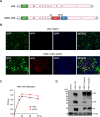A versatile H5N1-VSV platform for safe influenza virus research applications
- PMID: 40778766
- PMCID: PMC12455992
- DOI: 10.1128/jvi.00975-25
A versatile H5N1-VSV platform for safe influenza virus research applications
Abstract
The H5N1 strain of influenza A virus (IAV) continues to cause severe infections in a range of avian and mammalian species, including sporadic but concerning cases in humans. There is growing concern that circulating H5N1 strains could lead to widespread human outbreaks. Research with highly pathogenic H5N1 viruses is restricted to Biosafety Level 3 (BSL-3) laboratories. Vesicular stomatitis virus (VSV)-based vaccine vectors expressing heterologous viral proteins from Ebola, SARS-CoV-2, Lassa virus, etc., have previously been shown to be safe and effective in animal models and human clinical trials. Here, we report the development of a recombinant VSV expressing the hemagglutinin (HA) and neuraminidase (NA) genes of H5N1 IAV (H5N1-VSV), which serves as a versatile platform to study various aspects of H5N1 IAV biology. H5N1-VSV replicated robustly to titers comparable to those of the full H5N1 virus in multiple cell lines. In mice, H5N1-VSV vaccination was safe, elicited strong immunity, and conferred protection against a circulating H5N1 strain. Notably, we found that polymorphisms in antigenic site Sa of circulating strains emerged under immune selection pressure in cattle, resembling the evolution of pandemic IAV in humans. These findings suggest that H5N1-VSV can serve as a safe, adaptable platform for influenza research.
Keywords: H5N1; H5N1-VSV; VSV vector; influenza virus.
Conflict of interest statement
The authors declare no conflict of interest.
Figures




References
-
- Wohlbold TJ, Nachbagauer R, Xu H, Tan GS, Hirsh A, Brokstad KA, Cox RJ, Palese P, Krammer F. 2015. Vaccination with adjuvanted recombinant neuraminidase induces broad heterologous, but not heterosubtypic, cross-protection against influenza virus infection in mice. mBio 6:e02556. doi: 10.1128/mBio.02556-14 - DOI - PMC - PubMed
Publication types
MeSH terms
Substances
Grants and funding
LinkOut - more resources
Full Text Sources
Medical
Miscellaneous

